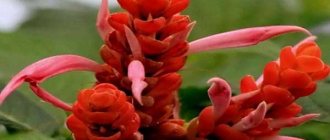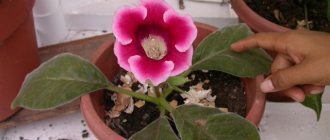Modern gardeners still have not agreed on which plant is called an azalea and which is called a rhododendron. According to the reference book of biology, azalea is the collective name for a subgenus, a group of individual beautifully flowering plant species from the large genus of rhododendrons. This definition has not caught on in everyday life, and azaleas usually mean indoor versions of these flowers, while outdoor plants and garden azaleas are rhododendrons.
In addition to their habitat, azalea and rhododendron differ in appearance. Azaleas have five stamens on their flowers, while rhododendrons have 10 and sometimes more.
How to choose
When purchasing, choose a medium-sized flower. The big ones don't adapt well, and the little ones are too weak. Pay attention to the leaves: if they are fat and dark green, it means the plant is overfed with phytohormones. Healthy azalea leaves are soft and light green in color.

Look for dry leaves on the flower. To do this, tilt the pot and shake it slightly. Check soil moisture. It should not be overdried or flooded, just slightly damp. Make sure there are no plant diseases. Be sure to ask the seller how often he waters the flowers and by what method.

When purchasing this plant, take a bush with buds and a couple of open flowers. This flower is more accommodating and strong. Before going to a flower shop, carefully read the photos of azaleas and the characteristics of the varieties, and then the purchase will bring you joy.
Main types of azaleas for the home
Caring for a plant at home is not easy. Only 2 types of azalea have adapted to being kept in an artificial environment:
| Name | Description | Flowers | Leaves |
| Indian (Sinsa) | Indoor variety. Up to 50 cm in height. Stems with hard, red-brown hair. | White, scarlet, motley. The buds open at the same time. | Ovate, on shortened petioles. There are soft hairs on the inside. |
| Japanese | Usually grown in garden plots. Reaches 40-60 cm. A distinctive feature is winter hardiness, withstands down to -20 ° C. | From salmon to dark red. They bloom with leaves at the same time, sometimes earlier. | Up to 5 cm. |

Varieties of Indian azalea
The azaleas that decorate living spaces are hybrids of the Indian variety. Common varieties:
| Name | Description | Flowers |
| Snowflake | Strongly branching shrub. Resistant to fungal and bacterial infections. | Non-double, lilac-pink with brick dots. |
| Albert-Elizabeth | Blooms buds at the end of winter. | Large, snow-white or light pink, with frames and corrugated edges. |
| Celestina | A spreading shrub that blooms from early spring. | Single, bright crimson. |
| Starfish | A bush of compact size with dark green, shaggy leaves. | Snow-white with crimson streaks at the base. |
| Madame Joly | Deciduous hybrid. | Simple, pinkish, orange-yellow at the base. |
| Czardas | Produces buds in April. Demanding on lighting. If there is a shortage of it, it loses its decorative appearance. | Creamy yellow, terry, with a pleasant aroma. |
| Satan | Up to 1.5 m. | Fiery red with yellow reflections. |
| Warbler | Forms a crown in the form of a ball. | White, with two corollas. |
| Golden lights | It blooms profusely, is frost-resistant, grows up to 1 m. | Golden yellow. |
| Azure | Low-growing shrub with many branches. | A rich blackberry shade with bright raspberry splashes on the inside. |
| Koichiro Wada | Variegated hybrid. Resistant to frost, easy to care for. | When unopened, they are crimson-pinkish, becoming lighter during flowering. |
Lighting
This plant loves sunlight. Contraindication for it is exposure to direct sunlight. Soft light or partial shade can be created on any windowsill if desired, but it is better to place the azalea on a window that faces west or east.
Read here Eucharis - growing and care at home. Tips for planting, watering and replanting a flower (125 photos and videos)

On a north window, the flower may not have enough light, which will cause the foliage to fall. The problem can be solved by lighting the flower with phytolamps. Also, additional light for azaleas is useful during the bud formation period (October-November).
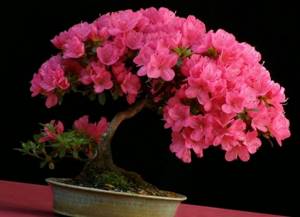
The south side represents the opposite case, where the plant runs the risk of getting too much light and drying out. Then create a shadow with a piece of paper or move the flower away from the window.
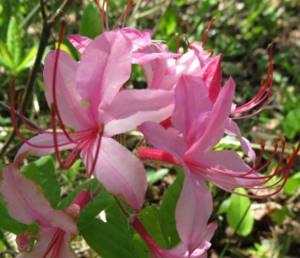
What you need to know about a flower before purchasing
Before purchasing a flower, you need to find detailed information, type: azalea care at home photo. If you choose different varieties and properly care for azaleas, then there is always a real garden on the windowsill from November to May:
- on early flowering ones in November-December;
- mid-blooming in December-February;
- late bloomers in February-May.
If the region has a mild climate, then the azalea indoor plant grows well in the garden
Azalea grows in the vast expanses of China, Japan, southeast Asia, the southern regions of Europe and North America. Indigenous people believe that a flowering plant brings happiness and peace. Azalea bonsai surprises anyone.

Azalea Bonsai
Azaleas are usually given as gifts when they bloom profusely. Those people who do not know the characteristics of the plant simply throw the flower away after flowering. The reason for the shedding of leaves is the discrepancy between the climatic conditions in the apartment. The fact is that the plant is demanding of humidity and temperature at different periods of its life. For example, in winter you need no more than +12 degrees.
But the whims of azalea do not repel fans. Indoor flower is becoming more and more popular. But you definitely need to learn how to care for azaleas at home.
Temperature
One of the key parameters of a favorable environment for any plant is temperature. Following the rules below will provide proper care at home for such a demanding flower.
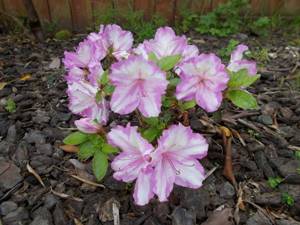
In summer, the ambient temperature should be above 20°C. Azalea l. The problem of heat can be solved by using an air conditioner.
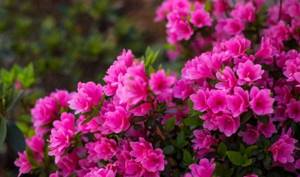
Acceptable temperature in winter is 15-18°C. A temperature of 10-12°C is most favorable for azaleas during the budding period.
Azalea propagation
Reproduction of azaleas is not easy and quite troublesome. From April to August, the shrub is propagated by stem cuttings. The entire process from cutting cuttings to first flowering takes from 2 to 3 years.
So how to propagate azalea at home? To do this, select shoots from last year's pinching, which are 7–10 cm long, and cut cuttings from them. The 3 lower leaves of each cutting are removed, forming a small cutting. All other leaves are shortened by half. Under the lowest bud, a sharpened knife makes an oblique cut.
Before planting, I tie the prepared cuttings together in groups of 10–15 and immerse the cuttings for 6–10 hours in a solution of a growth stimulator to accelerate the formation of young roots.
Then they make a mini-greenhouse. Pour a 2 cm layer of fine gravel, the same layer of coarse river sand and a mixture of peat with a coniferous substrate onto the bottom of a suitable container. The cuttings are deepened by 3–3.5 cm, the soil surface is generously sprayed and the greenhouse is covered with a transparent film.
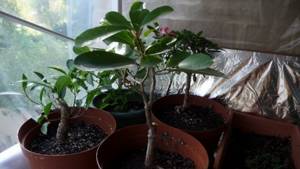
Already 7 days after planting, the cuttings are regularly ventilated, slightly opening the film. Do this for an hour in the morning, eliminating the possibility of drafts.
After a few months, the cuttings form a powerful root system. But provided that the temperature in the greenhouse is not less than 22 degrees and the humidity is below 80%.
Pay attention to this material - Kalanchoe: care at home.
As soon as the first shoots appear, the film is removed and abundant spraying and watering begin. When the shoots grow a couple of centimeters, they are planted in separate pots or seedling boxes (10x10 pattern).
For further branching and formation of the bush, after a couple of months, each top is pinched. The first buds must be removed so as not to burden the plant, which is not yet ready to flower.
You might be interested in this article - How to care for a cactus at home? Types and photos.
When the bush gets a little stronger and undergoes repeated pruning (after 2-3 months), it is transplanted into small flat pots with a drainage layer and a fertile light substrate.
Propagation by cuttings is a rather time-consuming but effective way to propagate azaleas.
Cuttings of azalea, video:
Watering and humidity
The soil should be moist. But the water should not stagnate. You can water the bush only with filtered, melted or settled tap water. The water should not contain chlorine or lime.

In autumn and winter, it is better to reduce watering and not spray the azalea. 1-2 times a month, the water is acidified in the following way: add half a teaspoon of lemon juice per liter of water.

Planting and caring for azaleas at home
Azalea after purchase
The azalea flower appears in stores, as a rule, from December to March, and if you bought a plant or received it as a gift, you need to know how to properly care for it, because a home azalea, if poorly cared for and in inappropriate conditions, sheds its buds and loses leaves and eventually dies.

How to care for an azalea? What conditions does this plant require? Domestic azaleas suffer from high temperatures and dry air: for normal development, 15-18 ºC is enough for them; during budding, the temperature should be even lower - from 10 to 12 ºC, and azaleas bloom at temperatures no higher than 20 ºC. Therefore, the purchased flower should be placed in the coolest place, away from operating heating devices.
- Hippeastrum
Bright sunlight is also harmful to azaleas, so place the pot with the plant on a western or northern windowsill. In the warm season (from May to October), it is advisable to keep azaleas in the fresh air - on a balcony, loggia, terrace or in the garden.
Soil for azaleas
Azalea develops well only in acidic soil: the pH value should be in the range of 4.0-4.5 pH. Buying a substrate for azaleas is not a problem; it is sold in every flower shop. But you can make the soil yourself: mix sand, moss and rotted pine needles in a ratio of 1:1:2. To disinfect, spill the substrate with a strong solution of potassium permanganate.
Watering
Water the azalea generously, every day or every other day, depending on the air humidity in the room. In extreme heat, you may need to water the plant twice a day, as the soil in the pot should be slightly moist at all times. You need to pour cold, settled water onto the surface of the soil. It is even better to use rain or melt water for moisturizing. Inventive azalea lovers came up with the idea of placing a layer of snow or pieces of ice on the ground: at above-zero temperatures they melt, and cold melt water penetrates into the soil. From time to time, add lemon juice to the water for irrigation (a teaspoon per 2 liters of water) to make the azalea bloom even more abundantly and brightly. Do not forget to drain excess water from the pan, otherwise the azalea roots will begin to rot.
If for some reason you have severely dried out the soil in which the azalea grows, you need to place the pot with the plant in a container of water for 3-4 hours, but so that the water does not overflow into the pot. When the earthen azalea ball is saturated with moisture, remove the pot from the water, allow excess moisture to drain from the drainage holes and place the plant in its usual place. Regular watering is resumed after 3-4 days.

In October, watering is gradually reduced, but in December, when the azalea begins to bloom, it will again need abundant moisture. By the way, azalea blooms for the first time at the age of three or four.
If the air in the apartment is dry, the exotic plant is unlikely to like it: the air in the room needs to be humidified using a fine spray, trying to prevent water from getting on the azalea leaves. You can place the pot with the plant on a tray with wet pebbles, but only so that the roots and pebbles do not come into contact. Or place jars of water around the plant.
- List of indoor palm trees (continued)
Top dressing
Feed azaleas with mineral fertilizers for flowering plants, making sure that they do not contain chlorine. It is best to use Azalea fertilizer for fertilizing: in spring and summer, fertilizing is applied once a week, and in winter - only once a month. During the formation of buds and during flowering, azaleas will need fertilizer with a high potassium content, for example, Kemira-lux or Uniflor-bud.
Trimming
In order for azaleas to bush better and bloom more luxuriantly at home, you need to pinch and trim the overgrown stems in a timely manner. After the blooming azalea has stopped forming new buds and the flowers have begun to fade, you need to remove the browned leaves from the bush, trim off weak and elongated shoots, and then remove all the flowers along with the pedicels. If there is a need to replant an azalea, the best time for this is immediately after flowering has ended.
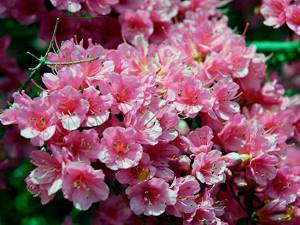
A month later, at the stage of development of 3-4 pairs of leaves on young shoots, their tops are pinched. You will need to pinch the ends of the shoots a couple more times, and then buds will appear at their ends again. The last pinching is carried out at the end of July or beginning of August, but this time it is not necessary to pinch all the shoots: only those that have become very elongated are shortened. Pruning (pinching) azaleas is a technique that increases the intensity of flowering. By the way, if, simultaneously with the formation of buds, new shoots begin to grow near them, they should be removed.
Transfer
Young azaleas are replanted annually, adult bushes - once every 2-3 years. The plant is replanted after flowering using the transshipment method. During the transshipment process, the earthen lump is not disturbed, which makes it possible not to disturb the roots of the flower.

The new pot is always larger than the previous one, shallow and wide. Such parameters are determined by the superficial root system of the plant. Also, when replanting, dried flowers, twigs, and stems must be cut off.
Varieties of azaleas
Breeders have developed many varieties of azaleas, differing in size, leaf shape, and petal colors.
But for this they used only two types: Indian and Japanese.
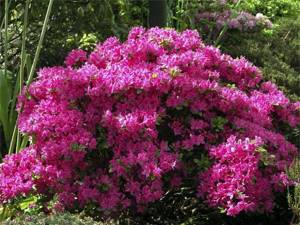
Azalea japonica

Indian azalea
In nature, these are dwarf shrubs. Their height does not exceed half a meter. The purchased flower can be grown like a tree.
Among the most popular varieties:
- Azalea japonica Melin
- Azalea Japanese geisha perp
- Rhododendron yellow Satan
- Azalia Chardas
- Azaleas kermesina
- Hybrid azalea "Slavka"
- Azalea japonica golden lights
Domestic azalea is a capricious flower and requires special care, only in this case will they please their owners.
Particular attention to lighting
Rhododendrons do not tolerate direct sunlight well; they prefer diffused light. If the weather permits, in the summer the flower can be taken outside, but in the shade. If it starts to rain, there is no need to remove the plant. This water procedure will be beneficial.
Air humidity
Azaleas like moist air, so they need to be watered frequently and generously. If the soil and air moisture are insufficient, the plant reacts violently by turning yellow, and then the azalea drops its leaves. Excessive moisture can destroy the roots of the plant.
It is useful to spray the leaves and the entire flower from bottom to top, the space around the azalea every day. In this way you can reduce the air temperature. It is convenient to carry out the procedure using a regular spray bottle with a fine spray. If the azalea is grown in a pot, it is usually placed in a tray. You need to put pebbles and moss in it. These two fillers prevent the water from evaporating for a long time, and a comfortable microclimate is created around the flower. You can install a fountain that drips water.
What you need to know about watering
Water the azalea flower with soft, cool, but not icy, water. You can use rainwater. If you use tap water, you need to let it sit and then boil it.
When caring for azaleas at home, you should know that the flowers require acidified water. Add a little succinic or citric acid to one liter of liquid.
Abundant watering is required on hot summer days. When buds appear on the plant, as well as in the autumn months, you need to water less, only as the clod of earth dries out. Remember, overwatering of flowers, including gabdelfat safin azaleas, has a detrimental effect on the root system. Some gardeners specifically purchase hygrometers.
Features of temperature support
Azalea rhododendron is picky about room temperature. In our homeland, the natural climate is cool. If an azalea suddenly drops its leaves, it means the room is too hot for it.
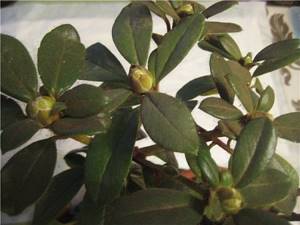
Azalea buds
When the plant begins to form buds, and this happens in October-November, you need to maintain a temperature within +7 degrees. When it starts to bloom, they increase it to +10 degrees. The rest of the time for azaleas, with proper care at home, it is enough to stick to +10-15 degrees.
It is clear that this temperature is not sufficient for people to live comfortably. You can achieve reduction for the flower by using dry ice to cover the pots, or by spraying the azalea with cold water.
What kind of soil does azalea like?
Plants prefer peat soils. But if the soil dries out, it becomes hard and water is not absorbed. The azalea directly in the pot should be placed in a large container and left for a while. Loosening is prohibited; the azalea's roots are too sensitive to damage.
Azaleas, especially kermesina, are demanding on soil acidity. It is advisable to maintain a pH of 4-4.5. If there is no peat mixture, you can use heather soil by mixing it with pine. It’s even better to use store-bought hydroponics or a composition for acidophilic flowers for successful cultivation.
Features of transplantation
When growing azaleas at home, they need to be pruned from time to time. Most often, azaleas are pruned after flowering. Then the flower is transplanted into another container. The procedure must be approached carefully, otherwise the roots will be damaged. It is better to re-handle the cut flower.
It is undesirable to be late with replanting, because the overgrown root system can rot and the plant itself can shed its leaves.
Attention: A young plant needs to be replanted annually, after reaching three years of age in 2-3 years.
When replanting, it is better to use ready-made soils purchased at a specialized store.
Caring for azaleas after transplantation is almost no different from usual procedures. It is necessary to water it with water and fertilizers every 10 days.
Choose the right fertilizers
After the purchase and subsequently, in the spring and summer, once every 10 days, the azalea is fed, choosing the correct proportion. There are a number of special fertilizers that can be purchased at flower shops. Rules of use in the instructions.
In the autumn-winter period, when buds appear, azaleas are fertilized with superphosphate.
When the azalea blooms...

Blooming azalea kermesina
If you want to have a profusely flowering plant, you need to know how to properly care for an indoor azalea flower at different stages of its life:
- First of all, timely pruning (starting in May) and pinching will be required. No more than 5 leaves are left on new shoots. This procedure is carried out constantly: a large number of leaves does not allow the formation of a large number of buds. And the flowers themselves are getting smaller.
- In order for azaleas, including purple ones, to delight with a riot of flowers for a long time, they need to be irrigated in a timely manner and create coolness around them.
- Each bud usually produces up to 4 buds. Is it possible to remove flowers that dry out? It is not only possible, but also necessary - this extends the flowering period, the plant itself does not lose strength.
- Don't forget to work on your azalea after it blooms. In addition to watering, pruning will be required. When an azalea blooms, it can be turned or moved to another place: the buds do not fall off or dry out. Proper care of azaleas at home, see photo, allows the plant to bloom more luxuriantly every year.
Diseases and pests
Diseases: their signs, causes, methods of elimination:
- If the leaves on the bush begin to dry out, it means that there is a lack of water or the flower is standing in the open sun. Solution: water, shade.
- Falling buds is a consequence of poor quality water. It is treated by introducing special fertilizers and changing water.
- The plant can get sick with gray rot, rust, and powdery mildew. Then you need to immediately treat the plant with chemicals.

The main insect pests of azaleas are:
- thrips;
- mole;
- hruschik;
- aphid;
- mealybug;
- fly;
- whitefly;
- mite;
- weevil.
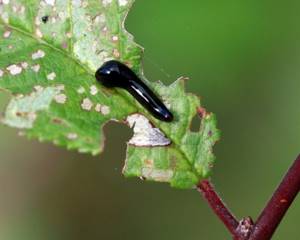
If pests appear, immediately treat the bush with an insecticide.

Mistakes in caring for azaleas, pest diseases
If not properly maintained, the azalea may become sick and insects will begin to eat it. Signs and treatments:
| Manifestation | Causes | Corrective measures |
| The leaves are falling. |
| Create the necessary conditions of detention. |
| Spider mite. | Spray with soap solution or Aktara, Fitoverm preparations. | |
| The greens turn yellow. | Chlorosis damage. |
|
| The flower withers, brown plaques and small insects are visible on the plates. | Shield. |
|
| The leaves are drying. |
|
|
| The greens dry out during the formation of buds. | Lack of moisture. | Moisten the substrate more often. |
| The plates turn black. |
|
|
| The bush withers, blooms poorly or does not produce buds at all. | Bad soil. | Replant in another soil and apply fertilizer. |
| The tips of the leaves become brown. | Watering with hard water. | Use soft, settled liquid. |
| The greens turn yellow and wither. Stems and roots rot. | Fusarium. |
|
| Red-brown or brown spots appear on the leaves, eventually spreading to the entire above-ground part. | Septoria. |
|
| Ash-gray or brown spots are visible on the inside of the plate. | Phyllosticosis. |
|
| There is a snow-white coating and lumps resembling cotton wool at the bottom of the leaves and at the base of the stems. | Mealybug. |
|
| White butterflies that fly away at the slightest touch. | Whitefly. |
|



